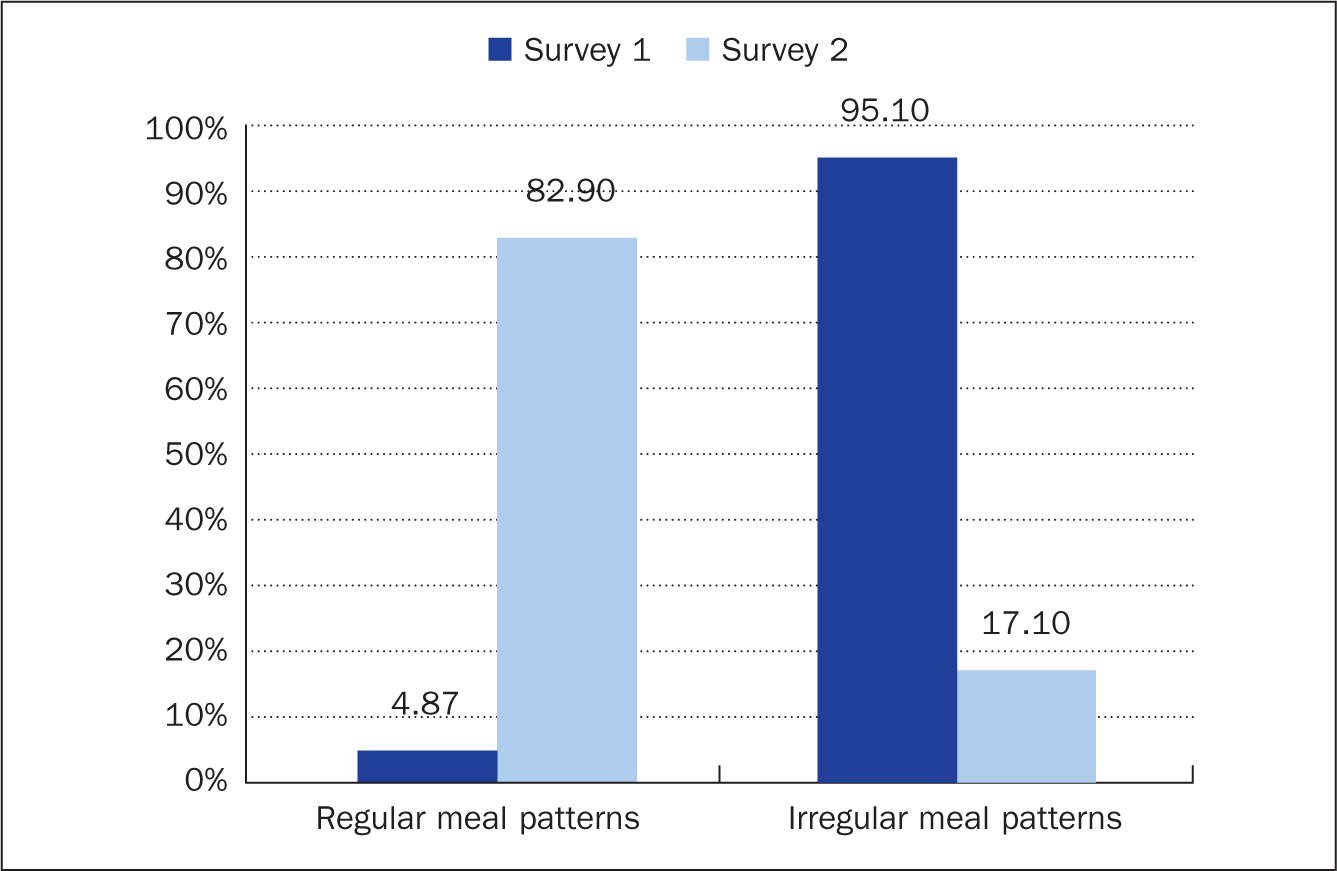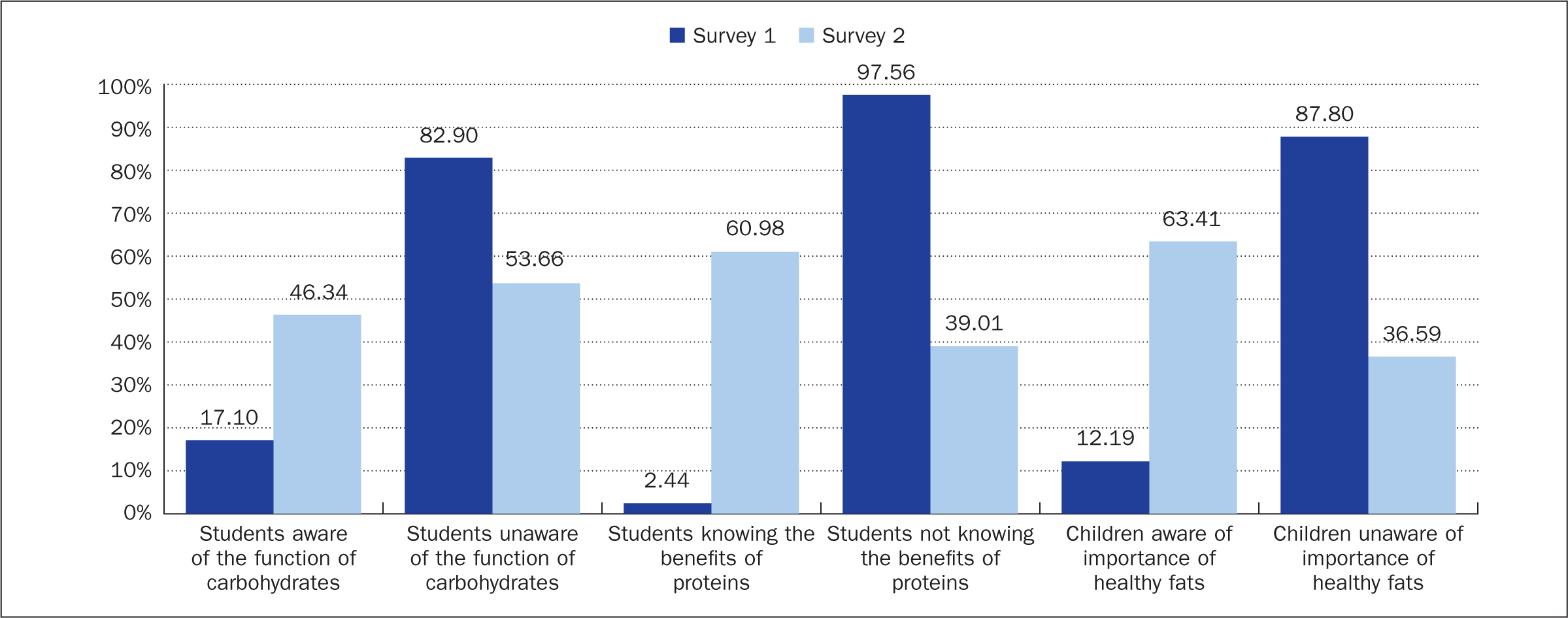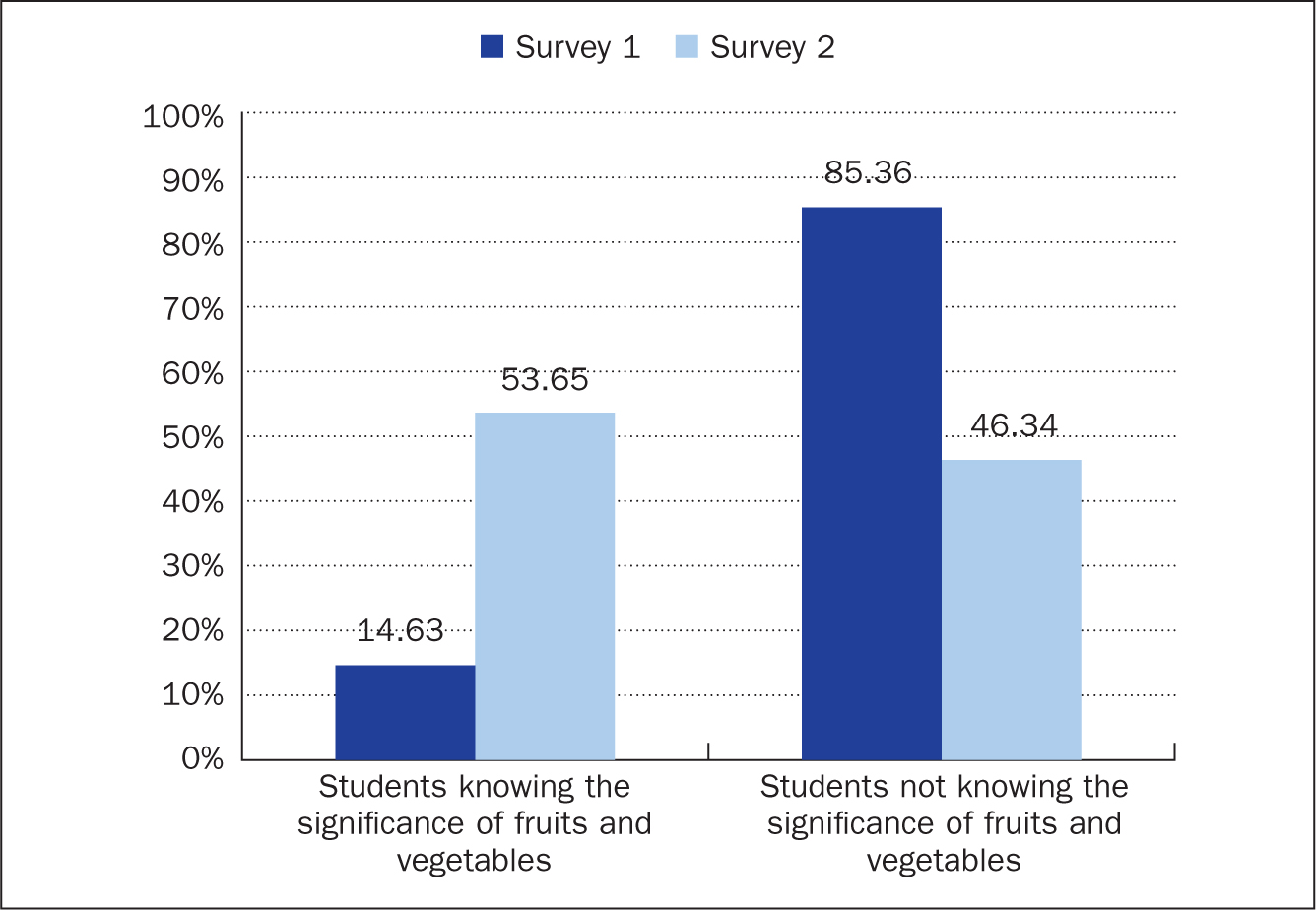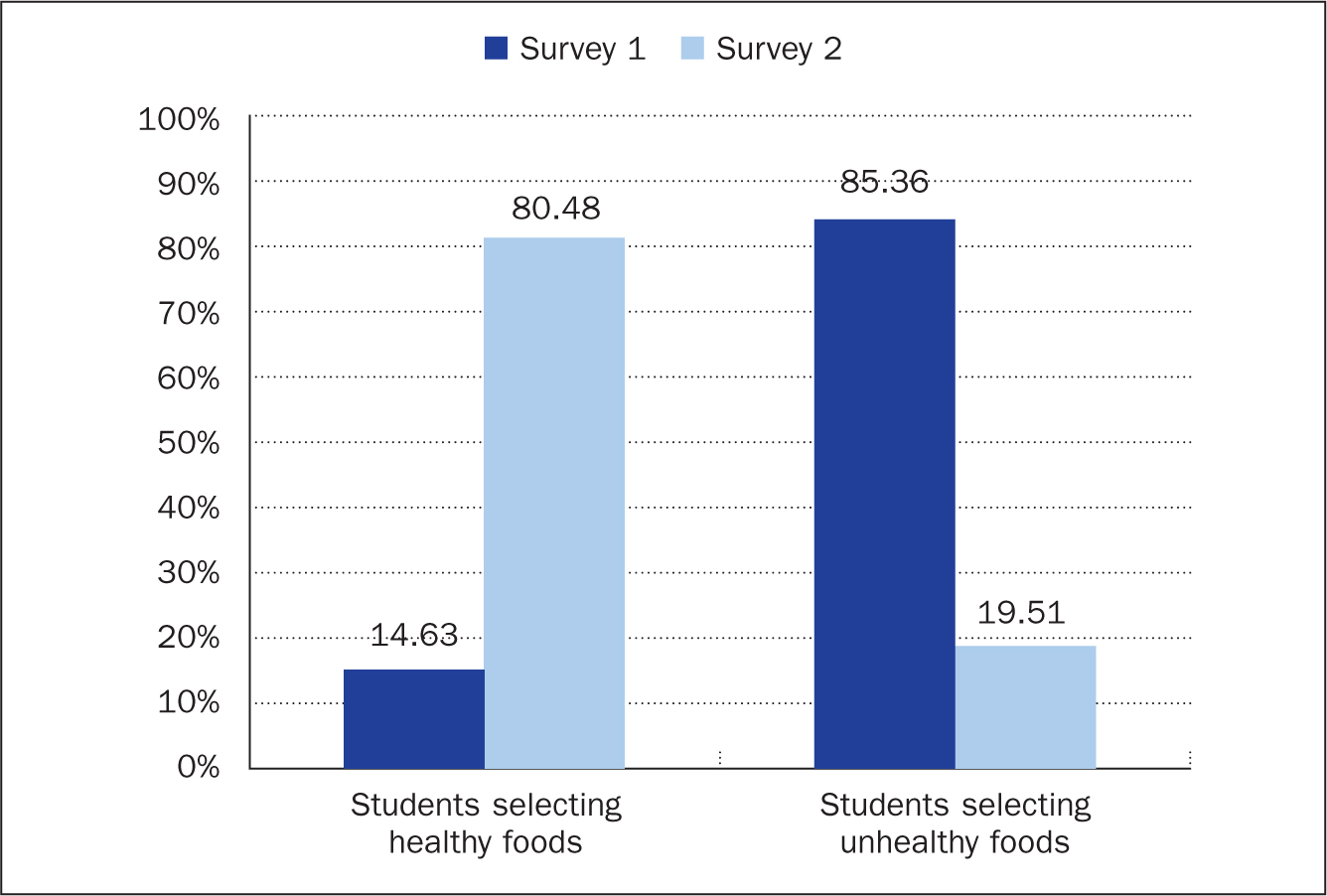Childhood is the period of life characterised by the fastest growth and development after infancy, compared with later life stages, and the dietary habits developed at this stage affect the child's wellbeing, health and overall quality of life. Therefore, children should be enabled to make conscious and healthy dietary decisions so that they can live healthy lives with a greater than average life expectancy. Research by Fryar et al (2021) found that 17% of British children aged 2–15 years are obese and 14% of children are overweight. The same study also found that, in the USA, 17% of the population aged 2–19 years is obese, while 16% of the population within the same age range is overweight. These findings are credited to poor dietary habits and food choices arising from a lack of nutritional knowledge. Good nutrition in childhood is essential to help children learn how to manage their food choices and calorific intake effectively. Intake of adequate nutrition makes people healthier and thus makes the community more productive and establishes better opportunities to ward off cycles of hunger and poverty (Bender and Cunningham, 2021). The current situation of obesity followed by increasing rates of several conditions including diabetes, cardiovascular disease and hypertension means there is an urgent need to raise childhood awareness of what is meant by good nutrition and healthy food choices. This requires the implementation of nutrition education to improve sustainability and the adoption of nutritional science in daily life, through frequent interventions based on contemporary findings (Swindle et al, 2019).
Method
Studies carried out by various researchers including Rathi et al (2017), Baute et al (2017), de Vlieger et al (2019) and Cooper and Contento (2019) all concluded that today there is an immense need for nutrition education, especially in young children so that healthier communities will develop. Taking into account the findings of previous studies in the subject area, a quantitative study was designed to meet the specific research aim of providing nutrition education to primary school children and assessing the outcomes. The author selected a group of primary school children using convenience sampling (taking samples that were conveniently available around the researcher's location) and took written consent from the headteacher as well as the parents of the students, the author's higher education institute and tutor. Convenience sampling was undertaken to meet the time allowed for a master's degree research study, and ease of sampling accessibility to the researcher as proposed by Etikan et al (2016).
Inclusion criteria
According to James et al (2020), children aged between 6 and 10 years have significant morphological awareness that helps their reading comprehension develop so they would be more able to understand and respond to the study than younger children. Therefore, the researcher included 41 students in her study with ages ranging from 7 to 10 years studying in a primary school in London. All students were in Year 3 or Year 4 and were included in the research regardless of their ethnic background, socio-economic status or weight. Children within the specific age range of 7 to 10 years were included to ensure participants were at a similar mental development stage.
Exclusion criteria
After consultation with the children's teachers, children with disabilities involving hearing, speaking and vision were excluded from the research study, as were children above and below the age range of 7 to 10 years.
Research intervention
After the university's Scientific and Ethics Committee approved the research study proposal the research was conducted in one primary school in four sessions (each of approximately 30 minutes' duration) during September and October 2021. Forty-one students participated in the study. In the first and the fourth session, the survey was conducted through a planned questionnaire, and students were asked to answer the questions. The second and third sessions consisted of providing nutrition education to the children. During these sessions, children were taught about healthy eating habits and the functions of food and its components using simple and understandable language.
To make learning easy for the children, complex food terms were simplified according to their functions. For example, carbohydrates were referred to as ‘fuelers’, proteins as ‘builders’, and fats as ‘protectors’, while fruits and vegetables were described as ‘preventers’. Students were also provided with information regarding the benefits of healthy eating and the adverse health consequences of poor eating behaviours, including various diseases. Moreover, the author also explained the quantities of various food groups that should be eaten every day and what foods to eat in larger quantities and what foods to eat in lesser amounts, using audio and visual aids. Tang and Intai (2018) found that audiovisual aids were highly effective in increasing attentiveness and understanding in children and increased their interest and enjoyment. Moreover, the same study also suggested that seeing rather than hearing information alone increases the ability to remember content and increases enthusiasm for a subject.
Results
Regularity in meal patterns
The first section of the survey evaluated the children's meal intake patterns, which is an important aspect of healthy eating. The results of the first survey found that only two students (4.8%) had regular meals such as breakfast, lunch and dinner at similar times each day, whereas 39 students (95.10%) did not have any regular meal intake patterns. However, attitudes towards meal intake were significantly improved post-intervention, with 34 students (82.90%) understanding that having regular meals was important for health; however, seven 7 (17.10%) did not show progress in this respect. See Figure 1.

Functions of carbohydrates
The second part of the survey consisted of questions regarding the functions of carbohydrates in the human body. The first survey showed that only seven students (17.10%) were aware of the functions of carbohydrates, whereas 34 students (82.90%) were not. The second survey, conducted after intervention increased the level of knowledge of carbohydrates in 19 students (46.34%) but 22 students (53.66%) remained unaware of the functioning of carbohydrates in the body. See Figure 2.

Benefits of proteins
The third question in the survey highlighted knowledge regarding proteins and their importance. The first survey showed only one student (2.44%) knew the benefits of proteins with 40 students (97.56%) unaware of their benefits. The results of the second survey showed a significant increase in knowledge regarding proteins with 25 students (60.98%) giving a positive response and only 16 students (39.01%) remaining unaware of the benefits of proteins.
Knowledge regarding healthy fats
Children were asked about their knowledge of healthy fats, which are an important component of the diet. The first survey demonstrated that only five children (12.19%) were aware of the importance of eating healthy fats, while 36 students (87.80) were not aware of their importance. After the intervention, the second survey showed that 26 children (63.41%) had learned the importance of healthy fats while 15 children (36.59%) remained unaware of their importance.
Purpose of eating fruits and vegetables
Fruits and vegetables constitute an integral part of diet and wellbeing. Therefore, children were assessed for their level of understanding regarding fruits and vegetables. The data obtained from the first survey showed six students (14.63%) had good awareness of the significant effects of fruits and vegetables whereas 35 students (85.36%) did not show a positive response to the question. However, the post-intervention survey showed that levels of knowledge on this topic had risen among 22 students (53.65%), with 19 students (46.34%) still showing a lack of knowledge regarding fruits and vegetables. See Figure 3.

Overall assessment of food choices
The final section of the survey provided students with a series of multiple food options, including both healthy and unhealthy food options and asked them to select the foods they preferred. In the first survey, only 6 (14.63%) students out of 41 selected healthier food options, whereas 35 (85.36%) selected the unhealthy food options. In the second survey, 33 students (80.48%) made healthy food choices, with 8 (19.51%) students making unhealthy food choices. See Figure 4.

Comparison of results
Although a large number of children improved their knowledge of healthy eating between surveys 1 and 2, a small number did not improve. This seemed to be because they had built up unhealthy eating practices and did not take an interest in the talks. More interventions, along with parental support and education, might help these children to improve their knowledge and therefore their diets.
Limitations
The study was conducted in a small group of primary school students in one school in London and therefore the results cannot be generalised. As children, particularly at primary school level, have limited agency, it might have been useful to include parents in the education sessions because it is they who plan, shop and cook food in the home.
Conclusion
The evaluation of students' nutritional knowledge before the educational intervention showed that there was a significant lack in nutrition knowledge, which could have been attributed to various factors, including a poor family food environment and lack of nutrition education in the curriculum. It was observed that, by using techniques such as teaching videos and relevant storytelling, the educational intervention was effective in the delivery of key learning points. The research survey also confirmed that two teaching sessions of only 30-40 minutes resulted in a significant change in their attitudes towards, and knowledge of, food. The author therefore advocates that nutrition education should be added as a key component of the education curriculum to facilitate the improvement in the dietary habits of primary school-age students.
It is hoped that the outcomes of the current study will inform future studies and the creation of future nutrition education programmes and resources with the major goal of integrating nutrition education within the primary school curriculum.
KEY POINTS
- Nutrition is the foundation for a healthy life, and eating habits, whether good or bad, are developed in childhood
- The majority of the children included in this study lacked information regarding healthy eating choices and healthy food habits
- The provision of nutrition education improved the majority of the children's attitudes towards healthy food and regular eating patterns
- Nutrition education and healthy eating have a lifelong impact and should be included as an essential part of the school curriculum
CPD reflective questions
- What changes should be made to the school curriculum and to school lunch menus in order to encourage healthy eating practices?
- What aids can be provided to students as a part of daily activities to help them learn about healthy eating?
- This research was carried out with a small group of subjects. How could nutrition education be provided to a larger population?
- What further work could be done in this area?


